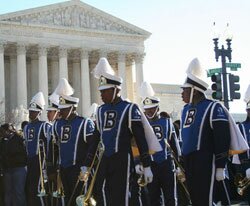 |
 |
 |
|
|
||||||||||||||
|
|
||||||||||||||
| Email Article | Printable Page |
Black College Students Demonstrate as High Court Considers Race Cases
 |
|
Credit: The Hilltop
Protesters walked from the Supreme Court to the Lincoln Memorial, a focal point of the 1963 March on Washington.
|
Two protesters held a sign that stood out among the sea of picket signs bearing catchy phrases and rhymes.
"No mas tratamiento de segunda clase!" this sign read. That translates to, "We will no longer accept second-class treatment." Its presence showed the ethnic diversity of the crowd led by Howard University students at the Supreme Court on Dec. 4 to support the continued use of race as a factor in maintaining racially diverse schools.
A group of more than 200 Howard students, led by the Howard University Student Association, gathered in front of the Supreme Court at 5:45 a.m. to lead the protest involving two high-profile court cases regarding education.
The protesters, organized with the help of the civil rights organization By Any Means Necessary and many different Howard student organizations, grew to several hundred by 10 a.m. and included student organizations from colleges and universities across the nation, and labor groups, civil rights groups and teacher unions.
"Howard University led the protest," Shanta Driver, founder of By Any Means Necessary, told the racially and ethnically diverse crowd. "I commend them for helping out with this effort."
 |
|
Credit: By Any Means Necessary
Protest in front of the Supreme Court on Dec. 4 drew students from around the nation.
|
At around 10:35 a.m., protesters spilled into the street, prompting Metropolitan Police officers to direct them back into the designated protest area on the sidewalk in front of the court. At noon, the protesters left the court steps and walked to the Lincoln Memorial, a focal point of the 1963 March on Washington. There, they rallied for several more hours.
Stephen Nichols, vice president of HUSA, led early rallying efforts and said Howard would be seen around the world protesting for civil rights.
“I’m so glad that when people turn on CNN, they will see students who started at Howard University and marched their way here,” Nichols said to the energetic crowd. “We are not the complacent students that the media makes us out to be.”
Student organizations from universities and colleges that included Harvard University, the University of California at Berkeley, the University of Louisville, Fayetteville State University, Lincoln University, Morehouse College and Spelman College were represented. Students from Lincoln wore T-shirts bearing a picture of Lincoln alumnus Thurgood Marshall, who argued the plaintiffs’ side in the 1954 Supreme Court case Brown v. Board of Education that ruled desegregation in public schools to be unconstitutional.
Tony Anderson, a junior political philosophy major and the associate vice president of the Student Government Association at Morehouse, came with a group representing every school in the Atlanta University system except Morris Brown College.
“I’m here on the steps of the Supreme Court,” Anderson said. “We were here before the sun came up around all the people who look like me. It’s worth the 12-hour trip just to be right here at 7 o’clock in the morning.”
Although many of the day’s speakers emphasized unity in the fight for equality, Rosie Washington said the court decisions would directly affect African Americans over any other ethnic group.
“The implications of the cases affects us directly the most,” said Washington, a 20 year-old from the University of Louisville.
Nichols said that by helping to organize several student organizations from around the world, Howard students are showing that they are leaders for the global community.
“This isn’t just for African Americans,” said Nichols, who led the crowd in a rendition of the black national anthem, “Lift Every Voice and Sing,” and a call and response in which he asked, “Have we overcome?” The crowd responded, “We have and we will.”
He added, “Today is for the women, Hispanics, Asians and a lot of other minorities because we are no longer the minority. We are the majority. We came here today to galvanize people from around the world under one cause.”
Other speakers included Gregory Carr, a professor in the department of African-American studies, and Arnita Hayden, the organizer of the Howard University Undergraduate Student Assembly’s part in the march.
“Somebody in this crowd will be sitting on one of those seats one day, even if we cannot see the change today,” Carr said, pointing to the court behind him. “And make sure that this building represents the justice that this building is supposed to represent.”
Hayden said the country is already relapsing into segregation and that a favorable court decision for the plaintiffs would add to the relapse.
“This a slap in the face that the Supreme Court would even hear this case,” Hayden said. “From this day forward we will not get slapped in the face and just stand by and feel the pain.”
Stephanie Brown, the youth and college director for the NAACP, said she was proud to see so many come out to tell America that a moral re-evaluation was needed.
“We are here today," Brown said, "to tell America, you need to check your soul.”
Posted Dec. 5, 2006
In News
Lesser-Known GOP Candidates Debate on Morgan State Campus
HBCUs Figure in Obama's Campaign Strategy
2 Delaware State Students Shot on Campus
| Home | News | Sports | Culture | Voices | Images | Projects | About Us Copyright © 2007 Black College Wire. Black College Wire is a project of the Black College Communication Association and has partnerships with The National Association of Black Journalists and the Robert C. Maynard Institute for Journalism Education. |